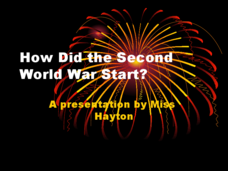Curated OER
Why do wars occur?
Understanding the causes of war is one way (possibly) to prevent it. World War II is used as a case study to facilitate an understanding of reasons why wars start. Topics covered included Totalitarianism, scarcity of resources, need for...
Curated OER
How Did WWII Start?
How did the second world war begin? A presentation first looks at the political climate that led to WWI and the effects of that war. Then, it describes the reason Hitler was able to take hold of Germany after WWI and prior to WWII. The...
Curated OER
History: Causes of World War I
Exploring WWI in an interesting discussion of the key events, this resource could be as a great supplement to a classroom unit on this topic. The pictures and information make this period in history come alive. Students would also...
Curated OER
The Roots of the Arab-Israeli Conflict: 1890s-1947
Consider and examine the roots of the Arab-Israeli conflict during the turn of the century. The topics covered in this presentation are not fully explained but are a perfect accompaniment to a full lecture. Issues to examine include The...
Tom Richey
Tom Richey: World War I for u.s. History
This slideshow will explore the reasons the United States joined into fighting during World War I. Explore the role Woodrow Wilson had during the war, the Treaty of Versailles, and the creation of the League of Nations.
Virginia History Series
Virginia History Series: Virginia State History 20th Century (1900 1920) [Pdf]
Delve into Virginia's pivotal role in America's early 20th century through this slideshow. Students can visualize WWI, Virginia's naval bases, and other events such as the suffrage movement and prohibition in Virginia. The slideshow...
Tom Richey
Tom Richey: 1920's Politics, Taxes, and Foreign Policy
Check out a comprehensive slideshow that dives into the key components of the American government which the people disagreed with following World War I.




